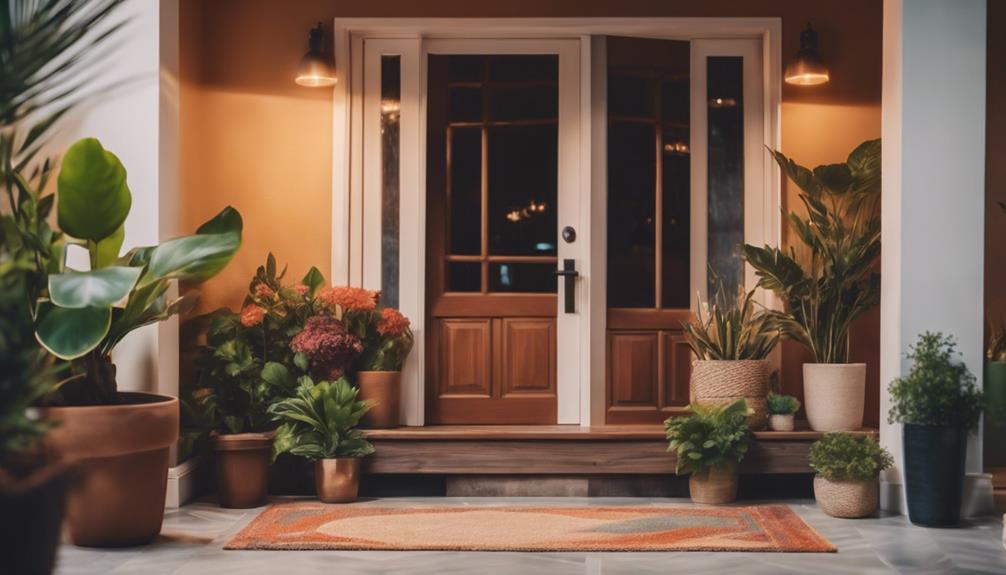Transform your entryway into a warm welcome by selecting functional furnishings that combine style and usability. Use long, shallow tables for limited spaces and incorporate accent pieces with storage, like benches or ottomans, to reduce clutter. Choose colors that reflect your personality, whether cozy dark shades or bright hues for a lively touch. Don't forget to organize with hooks for coats and trays for shoes. Enhance the space with mirrors to create an illusion of spaciousness and chic lighting. With a few personal touches, your entryway will invite guests in with open arms. Discover more ways to elevate your space effortlessly.
Key Takeaways
- Choose multifunctional furniture like benches or console tables with storage to keep the entryway organized and stylish.
- Incorporate warm colors, such as sunny yellows or soft creams, to create an inviting atmosphere.
- Add personal touches, like family photos or decorative items, to make the space feel welcoming and unique.
- Install stylish lighting fixtures to brighten the entryway and enhance its character.
Choosing Functional Furnishings
When choosing furnishings for your entryway, focus on pieces that blend style with functionality to prevent clutter and create an inviting space.
Opt for purposeful furniture that serves multiple roles. For example, long, shallow tables like the CORT Silver Console can maximize your limited space while providing a surface for decorative items.
Incorporate accent pieces with built-in storage, such as benches or ottomans, to keep essentials organized yet accessible.
Mirrors, like the CORT Catania Mirror, can enhance the feeling of spaciousness while adding a touch of elegance.
Prioritize durable materials that withstand daily use, ensuring your entryway remains both stylish and practical.
Color Choices for Impact
Choosing the right colors for your entryway can dramatically enhance its appeal and set the tone for your entire home.
Darker shades, like navy or charcoal, can create a cozy, dramatic effect, making your space feel more intimate. On the other hand, bright hues, such as sunny yellows or vibrant reds, can inject personality and energy, inviting guests to feel at home.
If you prefer a subtle approach, off-white shades like cream or linen offer a light, neutral backdrop that complements any decor.
Consider matching your entryway colors with your home's exterior to maintain architectural harmony.
Ultimately, your color choices should reflect your personal style and the overall feel you want your home to convey.
Organizing Your Space

A well-organized entryway not only enhances the space's visual appeal but also sets a welcoming tone for your home.
Start by incorporating hooks and hardware near the door to keep coats and bags off the floor.
Utilize doormats to trap dirt, ensuring your entryway stays clean.
Boot trays are essential for organizing shoes, preventing clutter from spilling into your living area.
Regularly declutter your entryway to maintain a tidy environment, and don't forget to add personal touches like family photos or decorative items that reflect your style.
This combination of practical storage solutions and personal elements creates a warm and inviting atmosphere as soon as you—or your guests—step inside. This thoughtful balance of functionality and personality ensures that your space feels like home, even when you’re thriving in a cold new city. The cozy ambiance welcomes you to unwind and provides a haven from the hustle of daily life. With every detail carefully curated, the space becomes a reflection of your journey and resilience. Whether it’s through soft lighting, cherished keepsakes, or intentional design choices, these details work together to transform your home into a retreat that nurtures both body and soul. By melding comfort with practicality, you create an environment that not only meets your needs but also tells your unique story. In this way, your home becomes more than just a living space—it becomes a sanctuary tailored to you.
Design Enhancements
Enhancing your entryway design involves thoughtful choices that blend aesthetics and practicality, creating a welcoming atmosphere right from the moment you step inside.
Start by choosing multifunctional furniture, like a console table with built-in storage, to keep clutter at bay. Incorporate mirrors to reflect light and give the illusion of spaciousness.
Don't shy away from color; whether you opt for bold hues or soft neutrals, ensure they harmonize with your home's overall feel.
Lighting is crucial—consider stylish fixtures that brighten the space while adding character.
Lastly, personalize your entryway with art or decorative items that reflect your style, making it truly yours and inviting for guests.
Ongoing Maintenance Tips

To keep your entryway inviting, regularly declutter and clean surfaces to maintain a fresh atmosphere. Make it a habit to check your entryway weekly, ensuring it stays welcoming and organized.
Here are some ongoing maintenance tips to consider:
- Declutter: Remove items that don't belong and keep only essentials visible.
- Clean: Wipe down surfaces and vacuum or sweep regularly to eliminate dirt.
- Rotate decor: Change seasonal decorations to keep the space feeling new.
Conclusion
So, go ahead and turn your entryway into a cluttered maze, where shoes pile up like a modern art installation.
Who needs a warm welcome when you can embrace chaos?
But if you truly want to greet your guests with charm, remember that a little thoughtfulness goes a long way.
With the right furnishings, colors, and organization, you can create a space that says, “Welcome home,” instead of “Good luck finding your way out!”










